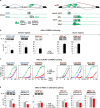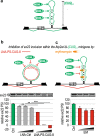Hybrid splicing minigene and antisense oligonucleotides as efficient tools to determine functional protein/RNA interactions
- PMID: 29242583
- PMCID: PMC5730568
- DOI: 10.1038/s41598-017-17816-x
Hybrid splicing minigene and antisense oligonucleotides as efficient tools to determine functional protein/RNA interactions
Abstract
Alternative splicing is a complex process that provides a high diversity of proteins from a limited number of protein-coding genes. It is governed by multiple regulatory factors, including RNA-binding proteins (RBPs), that bind to specific RNA sequences embedded in a specific structure. The ability to predict RNA-binding regions recognized by RBPs using whole-transcriptome approaches can deliver a multitude of data, including false-positive hits. Therefore, validation of the global results is indispensable. Here, we report the development of an efficient and rapid approach based on a modular hybrid minigene combined with antisense oligonucleotides to enable verification of functional RBP-binding sites within intronic and exonic sequences of regulated pre-mRNA. This approach also provides valuable information regarding the regulatory properties of pre-mRNA, including the RNA secondary structure context. We also show that the developed approach can be used to effectively identify or better characterize the inhibitory properties of potential therapeutic agents for myotonic dystrophy, which is caused by sequestration of specific RBPs, known as muscleblind-like proteins, by mutated RNA with expanded CUG repeats.
Conflict of interest statement
The authors declare that they have no competing interests.
Figures





Similar articles
-
Short antisense-locked nucleic acids (all-LNAs) correct alternative splicing abnormalities in myotonic dystrophy.Nucleic Acids Res. 2015 Mar 31;43(6):3318-31. doi: 10.1093/nar/gkv163. Epub 2015 Mar 9. Nucleic Acids Res. 2015. PMID: 25753670 Free PMC article.
-
In vitro correction of a pseudoexon-generating deep intronic mutation in LGMD2A by antisense oligonucleotides and modified small nuclear RNAs.Hum Mutat. 2013 Oct;34(10):1387-95. doi: 10.1002/humu.22379. Epub 2013 Aug 7. Hum Mutat. 2013. PMID: 23864287
-
Alternative splicing regulation by Muscleblind proteins: from development to disease.Biol Rev Camb Philos Soc. 2011 Nov;86(4):947-58. doi: 10.1111/j.1469-185X.2011.00180.x. Epub 2011 Apr 13. Biol Rev Camb Philos Soc. 2011. PMID: 21489124
-
The Muscleblind family of proteins: an emerging class of regulators of developmentally programmed alternative splicing.Differentiation. 2006 Mar;74(2-3):65-80. doi: 10.1111/j.1432-0436.2006.00060.x. Differentiation. 2006. PMID: 16533306 Review.
-
Understanding splicing regulation through RNA splicing maps.Trends Genet. 2011 Mar;27(3):89-97. doi: 10.1016/j.tig.2010.12.001. Epub 2011 Jan 12. Trends Genet. 2011. PMID: 21232811 Free PMC article. Review.
Cited by
-
[Construction of an adenovirus vector expressing engineered splicing factor for regulating alternative splicing of YAP1 in neonatal rat cardiomyocytes].Nan Fang Yi Ke Da Xue Xue Bao. 2022 Jul 20;42(7):1013-1018. doi: 10.12122/j.issn.1673-4254.2022.07.07. Nan Fang Yi Ke Da Xue Xue Bao. 2022. PMID: 35869763 Free PMC article. Chinese.
-
Translation of human Δ133p53 mRNA and its targeting by antisense oligonucleotides complementary to the 5'-terminal region of this mRNA.PLoS One. 2021 Sep 7;16(9):e0256938. doi: 10.1371/journal.pone.0256938. eCollection 2021. PLoS One. 2021. PMID: 34492050 Free PMC article.
-
Intrinsic Regulatory Role of RNA Structural Arrangement in Alternative Splicing Control.Int J Mol Sci. 2020 Jul 21;21(14):5161. doi: 10.3390/ijms21145161. Int J Mol Sci. 2020. PMID: 32708277 Free PMC article. Review.
-
Muscleblind-like 2 controls the hypoxia response of cancer cells.RNA. 2020 May;26(5):648-663. doi: 10.1261/rna.073353.119. Epub 2020 Mar 3. RNA. 2020. PMID: 32127384 Free PMC article.
-
Sustainable recovery of MBNL activity in autoregulatory feedback loop in myotonic dystrophy.Mol Ther Nucleic Acids. 2022 Nov 3;30:438-448. doi: 10.1016/j.omtn.2022.10.023. eCollection 2022 Dec 13. Mol Ther Nucleic Acids. 2022. PMID: 36420218 Free PMC article.
References
Publication types
MeSH terms
Substances
LinkOut - more resources
Full Text Sources
Other Literature Sources
Research Materials

